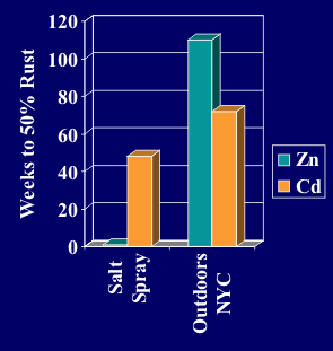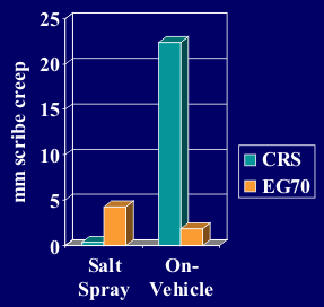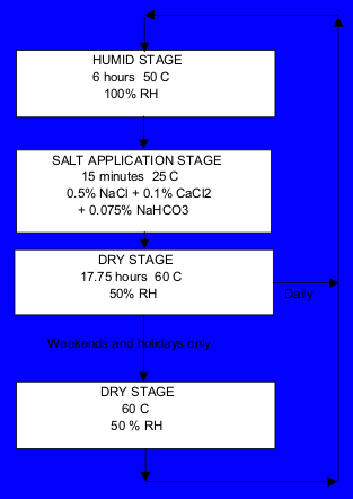
 |
There are several problems with ASTM B117 salt spray test when trying to rank the corrosion performance of automotive parts. Several studies have come to the conclusion that ASTM B117 does not provide a good test for coated aluminum alloys, or fails to predict the composition effects of aluminum-zinc alloy coatings on cold-rolled steel, or any other coatings for this matter. (reference)


The reason that the ASTM B117 test methods do not accurately reproduce corrosion performance for auto parts is that they do not accurately reproduce the conditions in which automotive parts must exist. For one thing, parts tested in a salt-spray cabinet are continuously wet, while those parts on a vehicle experience periods of wetness and dryness.
Another difference between the conditions in a salt spray test and real-world conditions is the salt concentration. Salt spray tests use solutions with a very high salt concentration (as high as 5%) that is much higher than concentrations found in the real world.
Other differences include the temperature changes that occur in the real world and the fact that real-world conditions include salts other than NaCl. The result is that salt spray test methods produce different corrosion mechanisms and different corrosion products than the more realistic, but more expensive, outdoor testing.
So, what’s an automotive test engineer to do? Easy. Get a copy of SAE J2334, “Cosmetic Corrosion Lab Test.”4 SAE J2334 was developed by the Corrosion Task Force of the Auto/Steel Partnership, a consortium whose membership includes the three major U.S. automakers and nearly all of the major steel producers.
SAE J2334 is a relatively simple test to perform. As shown in the following figure, one test cycle requires 24 hours and has three stages. You can run the tests manually or automatically. When run manually, the standard allows for the fact that test personnel may not be available during weekends. When this is the case, you extend the dry stage over the weekend.
When running the test automatically, you do not need the extended dry stage. Another difference between manual and automatic tests is that during automatic testing, you can use a salt spray in place of a salt dip.

A Lot of Hard Work Tests specified in SAE J2334 are the result of many years of research. One of the first steps was to develop a set of standard materials that the researchers could use to compare the laboratory tests to outdoor on-vehicle tests. In 1988, they selected ten standard materials, including coated and uncoated parts, with a wide range of coating compositions and thicknesses.
To determine the real-world performance of these materials, researchers then ran a series of tests. In one test, they mounted panels of the standard materials on pickup trucks driven in Montreal, Quebec, and St. John’s, Newfoundland, two of the most corrosive environments in North America. They drove the trucks for five years and then measured the corrosion performance of the materials. The researchers also ran similar experiments in Michigan, Ohio, and Pennsylvania.
The researchers then tested the standard materials with many different test methods, including SAE J2334, and then statistically analyzed their results to see which test method offered the best correlation to the real-world test results. The SAE J2334 test showed the best correlation. The analysis showed that 80 cycles of the SAE J2334 test corresponded to five years of on-vehicle testing.
While the results so far have been very good, the researchers are continuing to refine and improve the test, in an effort to improve both the repeatability and reproducibility of the test. There are, for example, some differences in the way labs achieve 100% humidity. These differences can lead to differences in test results. Researchers are also working on improving the method for salt application.
Once researchers have agreed on what changes to make in the test procedure, they will run a round-robin test to determine if the changes are really improvements. Then, assuming that they are actually improvements, they will revise the standard and submit it to SAE.